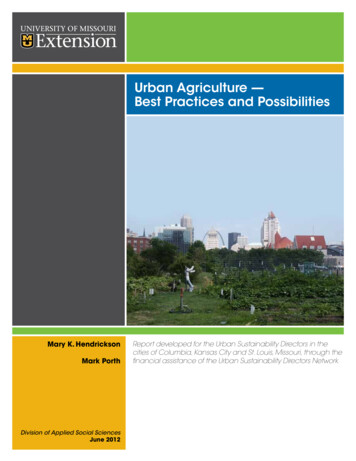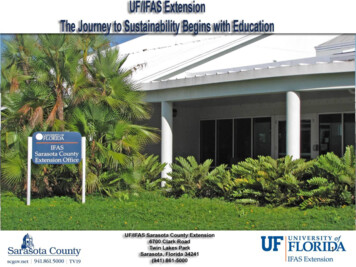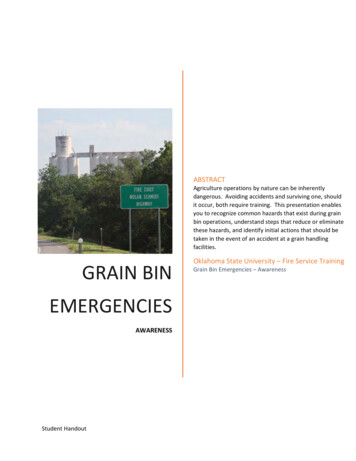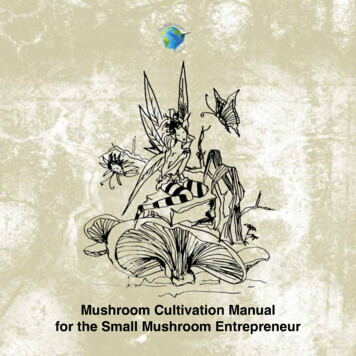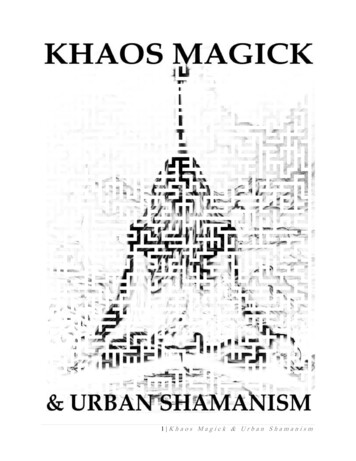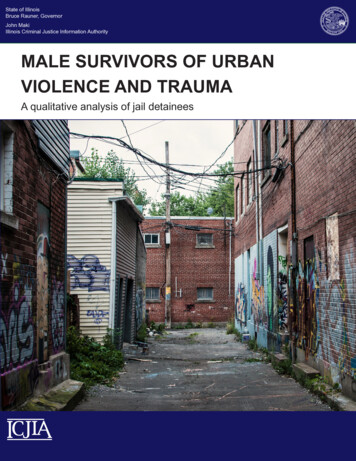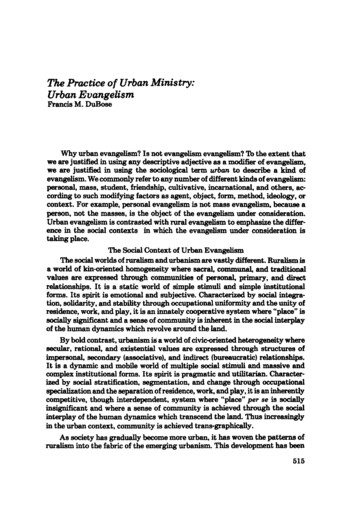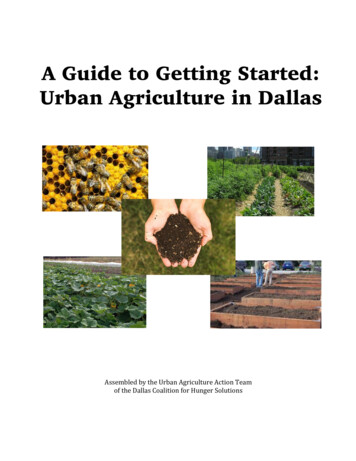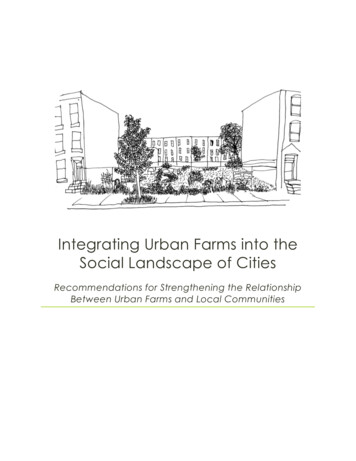
Transcription
Integrating Urban Farms into theSocial Landscape of CitiesRecommendations for Strengthening the RelationshipBetween Urban Farms and Local Communities
Integrating Urban Farms into the SocialLandscape of CitiesRecommendations for Strengthening the Relationship betweenUrban Farms and Local CommunitiesMelissa N. Poulsen, MPH & Marie L. Spiker, MSPH, RDJohns Hopkins Bloomberg School of Public HealthWith illustrations by Alex WinchJuly 2014
ACKNOWLEDGEMENTS:First and foremost, we are indebted to the many study participants who made this researchpossible by generously sharing their time and thoughts with us. We would also like to thank Dr.Peter Winch for his guidance, support, and commitment to multidisciplinary research, andNestor Mojica for his invaluable contributions to the study as a researcher. In addition, manythanks go to Dr. Larissa Jennings, Dr. Roni Neff, and Dr. Kate C. Smith for their intellectualsupport of this research.This research was made possible by the Johns Hopkins Center for a Livable Future-LernerFellowship and a fellowship from the Johns Hopkins Environment, Energy, Sustainability, andHealth Institute.
Table of ContentsEXECUTIVE SUMMARYIDEFINITION OF TERMSIIIINTRODUCTIONSTUDY OBJECTIVE12CHAPTER 1. BACKGROUNDBENEFITS OF URBAN AGRICULTUREDEFINITION OF URBAN FARMINGURBAN FARMING IN BALTIMORE CITY3333CHAPTER 2: STUDY METHODSSTUDY LIMITATIONS47CHAPTER 3. POSITIONING URBAN FARMS: NOT JUST A FARM IN THE CITYTHE ROLE OF THE URBAN FARMERSERVICES URBAN FARMS PROVIDE TO NEIGHBORHOODSTHE IMPORTANCE OF COMMUNITY BUY-IN FOR URBAN FARMS881014CHAPTER 4. BARRIERS TO GAINING COMMUNITY BUY-IN FOR URBAN FARMINGLACK OF FAMILIARITY WITH URBAN FARMINGFARM AESTHETICSPESTSVANDALISMSAFETY AND PURITY OF FARM FOODREPLACEMENT OF POTENTIAL DEVELOPMENTDISTRUST OF “OUTSIDER” PROJECTSSUSTAINABILITY OF URBAN FARMS171717191920202022CHAPTER 5. STRATEGIES FOR GAINING COMMUNITY BUY-IN FOR URBAN FARMINGPHASE 1: GAINING ENTRY INTO A NEIGHBORHOODPHASE 2: INTRODUCING THE IDEA FOR AN URBAN FARMPHASE 3: ENGAGING THE NEIGHBORHOOD24242730CHAPTER 6: PUTTING THE COMMUNITY BUY-IN PROCESS INTO ACTIONDO ALL URBAN FARMS NEED COMMUNITY BUY-IN?A TIMELINE FOR GAINING COMMUNITY BUY-INRECOMMENDATIONS35353536REFERENCES42
Executive SummaryIn cities across the U.S., urban farming is gaining traction as a way of productively usingdegraded vacant land while increasing access to fresh produce within cities. As urban farmingcontinues to be promoted by municipal governments and others, it is important to understandhow to ensure these projects are viable. One consideration for urban farms located in populatedareas of a city is the reaction of residents who live in neighborhoods surrounding farms. Urbanfarms differ from urban gardens in their emphasis on income-generating agricultural activity. Assuch, they can challenge traditional images residents might have for how land is used in cityneighborhoods. Urban farming projects are most likely to survive and thrive if they have localsupport, but how can these projects gain community buy-in? Through interviews with urbanfarmers, neighborhood leaders, community residents, and other key stakeholders in BaltimoreCity, we sought to understand the processes that are most effective for gaining theacceptance of city residents for urban farming.Findings from our research demonstrate that urban farms are not simply farms located in thecity. Key distinctions between urban farms and their rural counterparts include theunconventional roles of an urban farmer and the range of services – both tangible and intangible– that urban farms can provide to surrounding neighborhoods. It is the perceived benefits ofthese services – including the potential to increase access to fresh produce to local residents,clean up vacant lots, provide employment and educational opportunities, create communitycenters, and promote community revitalization – that appear to drive much of the enthusiasm forurban farming. Yet in order to survive and thrive, urban farms require local buy-in. Justifying theneed for community support, interviewees highlighted the vulnerability of urban farms tovandalism and the importance of having the respect of the community so as to avoid being“sabotaged.” Additionally, interviewees emphasized that in order to make a meaningfulcontribution to the community, it is important to align the services an urban farm provides to aneighborhood with local residents’ needs and desires.A range of barriers can hinder community acceptance for urban farming. Through our research,we identified several common barriers, including a lack of familiarity with urban farming;negative impressions of the appearance of urban farms; concerns about pests, vandalism, andthe safety of eating farm food; fear that farms replace other, preferential, development; seeingurban farms as projects introduced by “outsiders” who exploit neighborhood resources; andconcerns about the long-term sustainability of urban farms.Urban farmers overcome these barriers and garner support for their urban farming projects byemploying a range of strategies. We classify these strategies in three main phases. The firstphase – gaining entry into a neighborhood – consists of strategies aimed at gaining familiaritywith a neighborhood and building relationships. The second phase – introducing the idea for anurban farm to a neighborhood – relates to the way in which a farm is framed as the idea isintroduced to the neighborhood. The final phase – engaging the neighborhood – is an ongoingprocess to encourage local residents to be involved with the farm.Based on these findings, we present recommendations for urban farmers, city planners, andothers who support urban farming to assist them in creating urban farming projects that areaccepted and embraced by communities. While community buy-in is essential for all urbanfarms located in residential areas, the degree to which urban farmers engage local communitieswill differ based on the goals they have for their farm. Therefore these recommendations are notintended to be a checklist that is applied to every urban farming project, but rather a fullspectrum of actions to consider when creating a strategy to gain community buy-in.i
Summary of recommendations:Phase 1: Gaining entry into a neighborhoodA. Ensure the site selected for an urban farm is not actively used for other purposes (e.g.family gatherings, parking, playfields) and provides an opportunity to improve blighted landB. Take steps to gain an understanding of the neighborhood context (including the history ofthe neighborhood and potential farm site, and neighborhood challenges and assets)C. Avoid assumptions about what local residents desire and take steps to identify ways theurban farm can provide services that they valueD. Forge relationships with community leaders or groups that can champion the idea for theurban farm and assist urban farmers to incorporate goals into their project that aremeaningful for neighborhood residentsE. Avoid perceptions that an urban farm is an “outsider project” by demonstrating dedication tothe neighborhood through active community involvementPhase 2: Introducing the idea for an urban farmF. Include local residents in the process of planning the urban farmG. De-mystify urban farming to overcome a lack of familiarity with the concept by sharingexamples of other urban farms via photographs and toursH. Proactively address common concerns about urban farming and explain potential benefitsfor the local neighborhoodI.Use multiple forums to present the idea for the urban farm, including community meetingsand engaging residents who live in direct proximity to the potential farm sitePhase 3: Engaging the neighborhoodJ. Create a welcoming environment at the urban farm siteK. Create opportunities for residents to be involved with the urban farmL. Provide opportunities for local residents to access farm produce; for farms with a mission ofproviding food for the neighborhood, consult residents to determine the types of food theywant to eat and convenient times/locations for distribution, and ensure food is affordableM. Communicate with residents to maintain a positive and active relationshipN. Maintain and beautify the urban farm to meet residents’ expectations for theirneighborhood’s appearance, including creating a sense of permanence in the space in theoff-seasonii
Definition of termsCommunity buy-in: Community buy-in refers to acceptance and support by a particularneighborhood or community of people for a decision or project. Gaining the buy-in ofcommunities for a particular program or project is generally recognized as important for itssuccess and survival. Without it, community members are unlikely to participate in or supportthe project, and may feel antagonistic towards its presence.Community garden: A community garden is a single site, which may or may not be broken intoindividual plots, that is gardened by multiple people. Produce is consumed directly by thegardeners or shared/donated, but is not typically used to generate income.Food desert: The term ‘food desert’ refers to a neighborhood that lacks access to affordablefresh produce, usually due to the absence of nearby supermarkets. Though methods fordefining whether a particular neighborhood is a food desert vary, the characteristics to considerinclude distance to a supermarket, median household income, vehicle ownership rates, and ameasure of the availability of healthy food at local businesses.Urban agriculture: Urban agriculture is the practice of cultivating, processing, and distributingfood in or around a village, town, or city [1]. Urban agriculture can involve animal husbandry,aquaculture, agroforestry, beekeeping, and horticulture.Urban farm: An urban farm is a type of urban agriculture that has a primary emphasis onincome-generating agricultural activity.Urban farmer: For this report, we use the term ‘urban farmer’ to broadly refer to the individualsor groups who start and manage an urban farm. This may be an individual or group of farmers,a community-based organization, or a for-profit company.iii
IntroductionFor many, the word ‘farm’ likely evokes imagery associated with rural farming – the sight of cornneatly aligned in vast rows, the smell of manure emanating from a barn full of animals, thesound of a tractor rumbling across fields. However, riding a wave of excitement about ‘localfood,’ a different type of farm is quickly springing up around the country that challenges thisimagery in every way: the urban farm.Like urban gardens, which are a common site in cities across the U.S., urban farms utilizeunused city space to produce food. However, urban farming differs from urban gardening in itsfocus on production: it is a commercial venture where food is grown for sale or broaderdistribution rather than for consumption by the grower. It also differs markedly from its ruralcounterpart. Compared to rural farms, urban farms are small – generally a few acres or less.The crops are diverse and frequently comprised of vegetables and herbs rather than commoditycrops. If animals are present, they are the small ones permitted by City regulations – chickens,rabbits, bees. There are no tractors.Of course, urban farms differ drastically from one another in terms of their goals, structures, andlocations. They may focus on production and profit, or they may make social and educationalgoals their priority. In terms of structure, they can range from a tight cluster of hoop housesanchored to an asphalt-covered lot, to something more like a large garden, overflowing withgreenery. As for location, urban farms are found in all types of urban spaces, ranging from aparking lot of an industrial section of a city to the center of a residential neighborhood. Andunlike rural farms, where the nearest neighbor might be miles away, the people one might seeat urban farms are diverse: the farmers, of course, but also a gaggle of student volunteers,neighborhood children learning how to plant seeds, a local resident stopping by to buy a bunchof carrots. And just beyond the boundaries of the farm: people coming and going from theirhomes, commuters driving past, passengers waiting across the street for a bus. Despitedifferences that may exist in their goals or structure, urban farms must integrate themselves intoa social landscape that is at once a challenge and an asset.The social nature of urban farming is a major motivation for growing food in a city as individualsand organizations work to increase access to healthy foods and connect consumers andgrowers. However, it also creates a new challenge for farmers, for the viability of urban farmsdepends in part on whether urban communities see farming as an acceptable use of city space.Urban farming not only challenges the traditional imagery of farming, it may also challenge theimage people have of urban living. Whether urban residents accept the idea of having a farm intheir neighborhood depends on whether they see the farm as benefitting their community. This,in turn, depends on how urban farmers interact with the neighborhood and the efforts they maketo engage residents and gain their support, as well as characteristics of the farm itself.Urban agriculture can provide substantial health, social, ecological, and economic benefits tocommunities. As one type of urban agriculture, urban farming also has the potential to offermany of these benefits. Considering this potential, it has been promoted at multiple levels,paralleling broader trends seen in urban agriculture. In Baltimore City, the site of this study,individuals and community groups have started urban farms as businesses and as non-profitsocial enterprises, bolstered by supportive municipal policies as well as local organizations.As urban farming continues to be promoted, it is increasingly important to examine its feasibility.One consideration for urban farms located in populated areas of a city is the reaction of theresidents who live in the surrounding neighborhoods. Urban farming projects are most likely to1
survive and thrive if they have local support, but how can these projects gain community buy-in?This is the subject of the study on which this report is based.Study ObjectiveThrough our research in Baltimore City, we sought to understand the processes that are mosteffective for gaining the buy-in of city residents for urban farming. Toward this end, our researchexplored the following questions: Why is it important for urban farming projects to have community buy-in? What characteristics of urban farming projects affect community buy-in? What strategies or processes do farmers and others use to gain community buy-in forurban farming projects, and are these perceived to be effective? What are the main barriers to achieving community buy-in for urban farming projects?Based on the findings of our research, this report provides recommendations for urban farmers,city planners, and others who support urban farming to assist them in creating urban farmingprojects that are accepted and embraced by communities. While Baltimore City is the setting forthis research, we believe that the lessons learned are applicable to other U.S. cities as well.Ultimately, we hope that this research will help farmers develop projects that thrive in thecomplex social landscape that defines urban farming.2
Chapter 1. BackgroundBenefits of urban agricultureExtensive research on urban agriculture, and particularly community gardening, demonstratesits potential to have a wide range of positive impacts on communities, including health, social,economic, and environmental benefits. These benefits are summarized in Table 1. Some ofthese benefits – such as the health benefits – stem from the very act of gardening, and so arenot specific to urban agriculture, while others – such as the environmental benefits – come fromthe creation of green space, and so are not specific to urban agriculture.Definition of urban farmingUrban farming is a type of urban agriculture that has a primary emphasis on income-generatingagricultural activity. It differs from other types of urban agriculture such as home gardens andcommunity gardens in that food is produced for commercial distribution rather than forconsumption by the grower. Farm produce and value-added products are distributed at differentlevels. For example, local residents might purchase produce at a neighborhood farm stand orlocal corner store, or they might receive produce in exchange for volunteering. Residentscitywide might purchase urban farm produce at a farmers market or eat it at a local restaurant.Institutions such as school systems also purchase produce from urban farms for use in theircafeterias.This report categorizes urban farms as following two main models: community farms andcommercial farms. The distinction is based how they interact with the surroundingneighborhood.(1) Urban community farms are located on sites chosen based on their potential topositively influence the neighborhood, with a main component of their mission to engageand educate community members. They are frequently run as non-profits and often relyon volunteer support and grant funding.(2) Urban commercial farms are generally started as entrepreneurial ventures and so arelocated on sites that are chosen for being most conducive to production farming. Theytend to be run as for-profits and often support paid employees.Urban farming in Baltimore CityThis research takes place in Baltimore City, where support for urban farming stems fromconcerns about an overabundance of vacant properties, a lack of access to healthy foods inmany low-income neighborhoods, and high unemployment rates, three interrelated problemsthat urban farms are seen as addressing. Community gardens have long been part ofBaltimore’s landscape, but since 2010, over a dozen urban farms have popped up around thecity through the efforts of individual entrepreneurs, non-profit organizations, and businesses,reflecting the grassroots excitement that exists in Baltimore around local food production. Themunicipal government, through the City’s Office of Sustainability, increasingly supports urbanfarms. This is evident by recent changes to Baltimore City’s zoning code to allow for agriculturaluses, a new program that provides water access to growers, the development of the City’s firsturban agriculture plan, and the implementation of a land-leasing initiative that leases vacantcity-owned land to qualified urban farmers.3
Table 1. Potential benefits associated with urban agriculture*Health benefitsFood access andsecurity Greater access to fresh, wholesome, organic, and/or culturally appropriate produce by gardeners [2-11] Improved access to fresh food within the larger community (e.g. via donations by gardeners) [4, 6, 1214] Cost savings on groceries and access to foods otherwise unaffordable in supermarkets [9, 11, 14, 15]Increased fruit andvegetable consumption Greater fruit and vegetable consumption by gardening households** [11, 13, 15-19] Increased preference for, consumption of, or willingness to try fruits and vegetables by youthparticipating in gardening programs [20-25] Source of physical activity [2, 6, 7, 9, 11]General health and well Mental health/therapeutic benefits, including: stress reduction, improved emotional health, cognitivebeingstimulation, creating a sense of pride and accomplishment, and provision of a connection to nature, aretreat from the urban environment and a way to spend time outdoors [2, 3, 6, 7, 9, 11, 26, 27]Social benefitsCommunitydevelopment[2, 3, 5-7, 9-11, 13, 14,26, 28-36] Provision of opportunities for social interaction, strengthening social ties and facilitating new socialconnections Reduced social isolation for community gardeners Increased community cohesion including increased pride in and attachment to one’s neighborhood Catalyst for community organizing and broader community improvementEducation and youthdevelopment Provision of opportunities to learn about the provenance of food, agricultural processes, and nutrition,and to develop new skills [5, 9, 12, 14, 37-40] Provision of constructive activity for youth that promotes youth development and as an alternative foryouth exposed to drug and crime economies, including wage-earning opportunities [12, 27, 38, 41]Cultural integration/preservation[3, 6, 9, 12, 14, 38, 42] Provision of opportunities for neighborhood residents to interact who otherwise would not have such animpetus Provision of opportunities for immigrants to develop ties with host and other ethnic communities, expandcultural competencies, and gain a sense of belonging Provision of opportunities for expression and maintenance of cultural heritage Provision of opportunities to strengthen intergenerational relationships4
Economic benefitsJob creationIncreased propertyvalues Employment opportunities, particularly for low-income and socially excluded populations (e.g. formerlyincarcerated individuals) [27] Increased property values surrounding community gardens [43]Environmental benefitsEcosystem services[27, 44-46]Increased biodiversity, including provision of habitat for pollinatorsReduced air pollution through filtration of particulates by vegetationMicro-climate regulation (e.g. reduction in the “urban heat island effect”) through transpiration processesIncreased rainwater drainage, reducing the risk of flooding, ground water contamination, and depletedgroundwater levels Recycling of organic waste (e.g. through composting) Noise reduction (due to the soft character of unpaved ground) Restoration of natural landscapes (e.g. waterways) Climate changemitigation As part of a local food system, reduces greenhouse gas emissions associated with transporting food[47]Improvements to builtenvironment Transformation of vacant lots into productive green space/neighborhood beautification [7, 9, 12, 27, 29] Provision of safe outdoor green space for urban residents [9, 10, 14, 29]Environmentaleducation[6, 27, 48] Improved environmental attitudes Provision of opportunities for environmental education and hands-on learning about ecologicalprocesses*Many of the studies cited here are exploratory studies that use qualitative methods, and the quantitative studies rarely measure change before and afterimplementation of an urban agriculture project, use a control group, or include a large sample. Therefore, these benefits are not “proven” benefits in terms ofhaving been rigorously measured.**Without longitudinal studies, it cannot be determined whether participation in urban agriculture increases fruit and vegetable intake or whether individuals whoprefer these foods seek out gardening opportunities.5
Chapter 2: Study MethodsWe used a case study approach to explore the relationship between urban farms located inresidential neighborhoods and the residents who live in proximity to them. Three types of caseswere included, comprising five sites (see Table 2).Table 2. Case types included in studyCase typeDescription of case# of sitesActive FarmFully operational urban farms (for at least one year) and thesurrounding neighborhood2New FarmVacant lots where a new urban farm was planned and thesurrounding neighborhood2Rejected FarmNeighborhood in which a proposal to start an urban farm on avacant lot was withdrawn based on objections by residents1All farm sites were located in residential areas, with housing along at least one border of thefarm site. The (existing and proposed) urban farms defining each study site included bothcommunity and commercial farms. Among the new farm sites, one farm had just broken groundat the time data collection began and was in production by the time data collection wascomplete, while no farming-related activity occurred at the second site during the study period.The neighborhoods surrounding each farm site were mostly low-income, with a greaterproportion of residents living below the poverty line (between 21% and 37%) as compared toBaltimore City as a whole (18%). The exception was the rejected farm site, which bordered twoneighborhoods, one of which had a lower rate of poverty (12%) than Baltimore City as a whole.The majority of residents living in our study sites were black (ranging from 79% to 97% of theneighborhood’s population, as compared to 64% of all Baltimore City residents).1We conducted interviews with 49 individuals: key stakeholders with expertise related to urbanfarming (n 8), urban farmers associated with each site (n 8), neighborhood leaders (n 12), andresidents of the study neighborhoods (n 21). See Tables 3 and 4 for additional informationabout the interviewees. We also conducted participant observation at farm sites in which therewas ongoing activity or viewed the vacant lot where the farm was supposed to be located.Following data collection and analysis, we developed a series of recommendations aimed athelping urban farmers gain community buy-in for their urban farming projects. To elicit feedbackon these recommendations, we held a dissemination meeting, inviting our study participants andother stakeholders to attend. During this meeting, we informed attendees of the resultspresented in this report and asked for their feedback on our draft recommendations. Throughdiscussion and written feedback from meeting participants, we re-assessed therecommendations in terms of feasibility to urban farmers and how much each would benefiturban residents. The final series of recommendations included in this report incorporates thefeedback we received from the dissemination meeting.1Data from the Baltimore Neighborhood Indicators Alliance (http://bniajfi.org/vital signs/cprofiles/).Income data is from 2011; race/ethnicity data is from 2010.6
Table 3. Number of interviewee types by tive farm sites (2)351220New farm sites (2)44513Rejected farm site (1)1348Total8122141Table 4. Demographics of neighborhood leaders and residents by case typeCase typeBlackWhiteHispanicMaleFemaleTotalActive farm sites (2)107071017New farm sites (2)801549Rejected farm site (1)340257Total21111141933Study limitationsThe purpose of our research is to understand how to effectively gain community buy-in for urbanfarming. For urban farming projects, community buy-in refers to the acceptance of an urbanfarm by members of the geographic community (i.e. the neighborhood surrounding the farm).However, a limitation of this endeavor lies in assuming that neighborhoods are made up of acohesive group with homogenous preferences and needs. In reality, the views of ourinterviewees represent their specific social, economic, and cultural perspectives, inherentlyexcluding others. Therefore, given the diversity of views inherent in any group, gaining the buyin of all members of a neighborhood for an urban farming project is an ideal rather than a reality.Another limitation to this study is that we were unable to identify residents or neighborhoodleaders who opposed the idea of urban farming. To some degree, this is due to a lack of interestby such individuals in participating in our research; however, it also reflects a lack of oppositionto urban farming. The majority of our interviewees had some interest in urban agriculture, hadestablished a relationship with the urban farm in their neighborhood, or appeared to play aleadership role in their neighborhood. However, this is also a strength, since our intervieweeswere generally interested in the research topic and so provided rich and insightful information.As with all qualitative research, it is important to consider contextual factors when transferringthe findings of this study to settings beyond Baltimore. However, we believe that the proposedrecommendations provide a springboard for developing community buy-in processes that aretailored to meet the needs of a variety of urban farming models.7
Chapter 3. Positioning urban farms: Not just a farm in the cityIn this chapter, we highlight findings from our study that demonstrate the ways that urban farmsare not simply farms located within cities, but rather unique projects that lay at the nexus of foodproduction and community development. Key distinctions between urban farms and their ruralcounterparts include the unconventional roles of an urban farmer and the range of services –both tangible and intangible – that urban farms can provide to surrounding neighborhoods. Wethen turn to the importance of community buy-in for urban farms, revealing that it is not onlyperceived to be a practical necessity to ensure that urban farms are not subject to vandalism,but is also driven by a sense of obligation among urban farmers to make a meaningfulcontribution to disadvantaged neighborhoods.The role of the urban farmerWhether an individual, a group of committed residents, a community-based organization, or afor-profit company, those who start and run urban farms contribute to the idiosyncrasy of urbanfarming. Our research findings reveal that urban farmers’ motivations often extend beyondentrepreneurial goals or personal interest in growing food, encompassing a desire to make apositive contribution to the neighborhoods where their farms are located. As one stakeholder putit, “they also want to be part of trying to do something about their world that they see aroundthem.”Among the urban farmers we interviewed, motivations ranged from wanting to see greater foodequity in disadvantaged neighborhoods, to providing employment, to creating opportunities forexperience-based education in agriculture. One community farmer said that while she waseager to grow food on a large scale, it felt “unfair coming into a neighborhood where there was alot of vacant land, growing food on it, and not sharing it with the community.” We found thatcommercial farmers also have social goals for their urban farms, or at least recognize theopportunities an urban
others who support urban farming to assist them in creating urban farming projects that are accepted and embraced by communities. While community buy-in is essential for all urban farms located in residential areas, the degree to which urban farmers engage local communities
